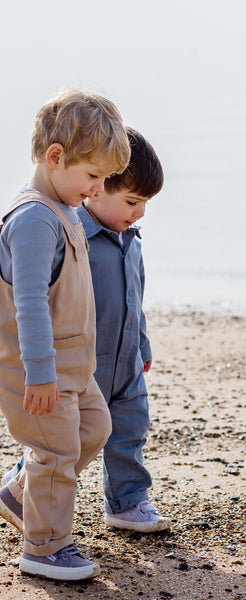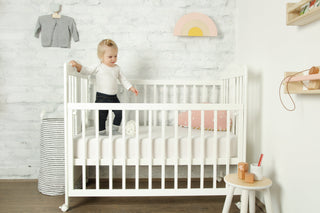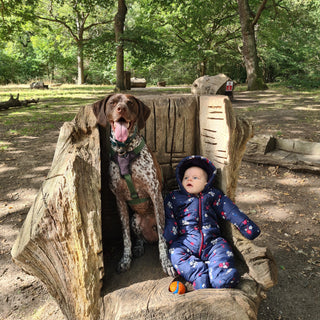When Freya was a toddler, I pulled out a pile of clothes her sister Darcey had worn 18 months earlier. I expected them to look a little tired, after all, they’d been through dozens of washes and plenty of playground adventures. But most of the organic cotton pieces looked almost new. The colours hadn’t faded, the seams were intact, and the fabric still felt soft. The same couldn’t be said for the few high street items in the pile.
That moment confirmed what I’d already suspected: organic cotton baby clothes don’t just feel nicer when you buy them, they hold up better over time. And when you choose them, you’re not just getting quality for your baby, you’re making a choice that’s better for the planet too.
Comfort That Lasts
One of the first things you notice about organic cotton is how soft it feels. But what I’ve learned over the years is that this softness isn’t just for day one, it lasts.
Conventional cotton can feel good initially, but the chemical processing it goes through often weakens the fibres. After repeated washing, it can lose shape, become rougher, or shrink in odd ways. Organic cotton, grown without synthetic pesticides and processed more gently, holds its structure and texture far longer.
That’s why Freya can wear Darcey’s old organic dungarees without them looking like “hand-me-downs” in the tired sense of the word. They still feel like special pieces, and she’s as comfortable in them now as Darcey was then.
Gentle on Sensitive Skin
Both of my girls have experienced dry, sensitive skin, and I’ve seen first-hand how the wrong fabrics can make it worse. Organic cotton is produced without the toxic dyes, bleaches, and chemical treatments found in many conventional textiles. That means fewer potential irritants next to your baby’s skin.
I’ve spoken to plenty of other parents who’ve noticed fewer flare-ups after switching to organic. It’s not a miracle cure for skin conditions like eczema, but it’s one less trigger to worry about. And as any parent dealing with sensitive skin knows, removing even one trigger can make a big difference.
Proven Sustainability Credentials
It’s easy for brands to throw around words like “eco-friendly” or “sustainable”, but without proof, these claims don’t mean much. That’s where GOTS certification comes in.
The Global Organic Textile Standard doesn’t just look at how cotton is grown, it also covers how it’s processed, dyed, and finished, with strict environmental and social criteria at every stage. A GOTS-certified garment is a guarantee that the cotton is genuinely organic and produced responsibly.
When shopping, I always recommend looking for that certification. It’s the simplest way to avoid falling for greenwashing.
The Misconception About Price
One of the biggest myths about organic baby clothes is that they’re always much more expensive. Yes, they can cost more than fast-fashion alternatives, but they’re not always out of reach, especially when you think long-term.
At Aneby, most of our pieces are under £15. We make them in small batches, using GOTS-certified organic cotton, and still keep them affordable. The reality is that if you buy a few high-quality items and rotate them, they’ll last longer and hold their value if you choose to resell them.
And let’s not forget second-hand organic clothing. Platforms like Vinted are full of bargains if you’re willing to spend a little time searching.
Lower Environmental Footprint
Conventional cotton is one of the most pesticide-heavy crops in the world. Those chemicals can harm ecosystems, pollute waterways, and damage soil health. Organic cotton is grown without synthetic pesticides and fertilisers, often using farming methods that support biodiversity and use water more efficiently.
For me, choosing organic cotton is part of the same mindset that led our family to go vegetarian almost a decade ago. It’s about reducing our impact where we can and making conscious choices in everyday life.
Why Smaller Brands Often Do It Better
I’ve found that smaller, independent brands tend to be more committed to sustainable practices than some of the bigger names. They can work in smaller production runs, focus on ethical supply chains, and avoid overproduction.
There’s also a level of care in the details, like using recyclable, plastic-free packaging or producing limited-edition designs to reduce waste. These aren’t just marketing points; they’re decisions that directly impact the planet.
And as a small brand ourselves, I know the extra work it takes to uphold those values, from sourcing certified fabrics to ensuring the people making our clothes are treated fairly.
Everyday Benefits You’ll Notice
Switching to organic cotton isn’t just about ticking a sustainability box, it has real, everyday benefits you’ll see and feel:
-
Better wearability – Clothes hold their shape and comfort after repeated washes.
-
Less fading – Colours stay vibrant for longer.
-
Longer lifespan – You can pass items down without them looking worn out.
-
More mindful shopping – Buying fewer, better pieces helps reduce clutter and waste.
How to Choose the Right Organic Baby Clothes
When you’re shopping for organic baby clothes, here are a few tips to make sure you’re getting the most from your purchase:
-
Check for GOTS certification – It’s your best safeguard against greenwashing.
-
Feel the fabric – Organic cotton should feel substantial and soft from the start.
-
Look at construction – Reinforced seams, quality stitching, and strong fastenings will extend the garment’s life.
-
Buy versatile pieces – Gender-neutral colours and simple designs work across seasons and for multiple children.
-
Consider second-hand first – Organic lasts so well that buying preloved is an excellent option.
Final Thoughts
Organic cotton baby clothes are more than just a fabric choice, they’re an investment in comfort, quality, and a better future for the planet.
You don’t have to replace every item overnight. Start with one or two key pieces, notice the difference, and build from there. Whether it’s the softness on your baby’s skin or the satisfaction of passing clothes down in beautiful condition, the benefits speak for themselves.
If you want to know how to build a whole wardrobe around those values, read Building a Green Baby Wardrobe or see my full overview in The Ultimate Guide to Organic Baby Clothes.











